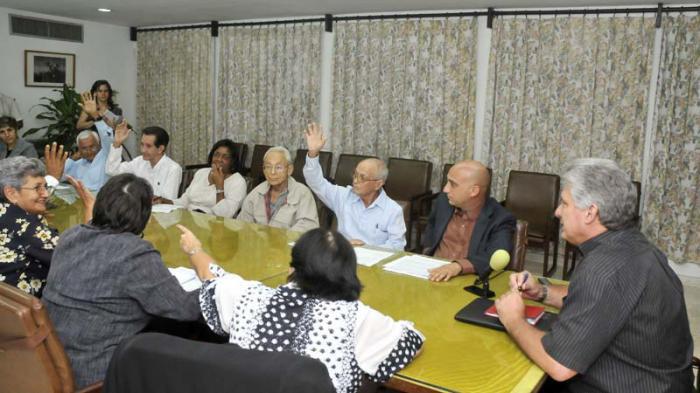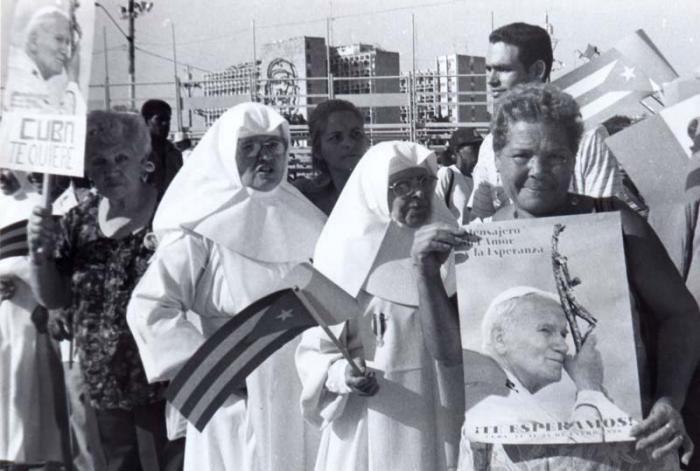
In the year of the 80th anniversary of the establishment of diplomatic relations between Cuba and the Holy See, and the 100th anniversary of the request by the veterans of the Cuban War of Independence for Our Lady of Charity to be declared Patron Saint of Cuba, Pope Francis will visit the country, one of the few in the world that has been visited by the last three popes.
As Cubans we are conscious, whether religious or not, of the fact that the Pope will be welcomed by a combative, noble and united people, accustomed to rising above difficulties and walking tall, despite having been subjected to a brutal economic, commercial and financial blockade for over five decades, and having confronted the limitations resulting from this without neglecting to defend our culture, identity and roots, while safeguarding the education of our children.
The Bishop of Rome will find a country that learns every day how to move forward with a progressive and constantly updated social project; a society that is built on the basis of the struggle for a better world; and whose history includes men such as Father Varela, José de la Luz y Caballero and José Agustín Caballero, to name but three examples, the synthesis of Cuban ethics, and for whom love of their homeland and of God were two consubstantial passions.
But above all, he will find a nation of cultural and religious multiplicity, the product of a process of transculturation, a term coined by Cuban anthropologist Fernando Ortiz, essential to an understanding of the history of the nation and of Latin America. A mix of beliefs and manifestations marks the country’s religious makeup, described by the researcher as complex, heterogeneous and contradictory, due to its origins, ideas and representations and ways of organizing and expressing itself through rituals, etc.

Within this diversity, in which the Catholic, Evangelical, Protestant and Orthodox churches coexist - Judaism, spiritualism, Afro-Cuban religions, Islam and Buddhism, among others - is perhaps one of the most legitimate examples of what is defended in Article 8 of the Constitution of the Republic of Cuba, relating to religious freedom:
“The State recognizes, respects, and guarantees religious freedom. In the Republic of Cuba, religious institutions are separate from the State. The different creeds and religions enjoy equal consideration.”
Article 55 also states: “The State, which recognizes, respects and guarantees freedom of conscience and religion, simultaneously recognizes, respects, and guarantees the freedom of every citizen to change religious creeds, or not to have any; and to profess the religious worship of their choice, with respect for the law. The law regulates the State’s relations with religious institutions.”
These principles have also been reflected in the thoughts and actions of the main leaders of the Revolution. Comandante en Jefe Fidel Castro Ruz met with Chilean priests in 1971 and expressed the need to “unite Christians and revolutionaries” in the struggle for freedom. Later, when visiting Jamaica in 1977, this time addressing a predominantly Protestant audience, he returned to the theme of the “strategic alliance” that should exist between religion and socialism.
Reflected in the first comments is the historical leader’s perspective of Liberation Theology; in the second example, his intention to change the situation at the time in regards to the relations between religions and the state.
Years later, as evidence of the maturity of the Cuban revolutionary process and in line with the wishes of both parties, meetings between the Comandante and evangelical and protestant leaders in Cuba began to take place – a tradition maintained today by the highest authorities of the government – until, in 1991, at the Fourth Party Congress, the wish of those believers eager to join the ranks of the organization was crystallized, an intention reiterated in January 2012 at the First National Conference of the Party.
There are currently three Protestant pastors, a Presbyterian, a Baptist and an Episcopalian in the Cuban parliament, elected by popular vote; and in the same way members of the Catholic Church and other denominations and religious manifestations form part of the organs of state power and political and mass organizations.
The activities undertaken by religious institutions in cooperating with the state in the management of hospitals and nursing homes are an example of their connection with the most pressing problems of society, particularly related to the family and the aging population. These issues have featured on the agenda of recent meetings held between representatives of the institutions and fraternal associations, and the country's leadership.
The scenes lived during the visits of Popes John Paul II in 1998 and Benedict XVI in 2012, reflected the similarities between the Cuban social project and Christian sentiments, in the effort to eliminate poverty and exclusion, in praising the role of the family, in defense of peace and against war, and in the preservation of the human species. In addition, they demonstrated the deeply humanistic culture of an entire people.
“I hold deep in my heart all the Cuban people, each and every one. You have surrounded me with prayer and affection, offered me cordial hospitality and shared with me your profound and rightful aspirations,” Benedict XVI said in his farewell address.
Meanwhile, John Paul II expressed, “I am grateful to you for your cordial hospitality, an authentic expression of the Cuban soul, and above all for being able to share with you intense moments of prayer and reflection.”
Other religious figures, including leaders of the Latin American Council of Churches, the Latin American Episcopal Council and the Caribbean Conference of Churches, general secretaries and presidents of the National Council of Churches of Christ in the USA, cardinals and other prelates of the Holy See, pastors, priests, rabbis, Yoruba leaders, Muslims, Buddhists and scholars, have also visited our country.
In 2011, the Cuban Interfaith Platform, which includes representatives of all religious manifestations, was created. Undoubtedly, of special significance was its struggle for the return of the Cuban Five imprisoned in the United States, and in establishing a bridge between them and their families. The Council of Churches of Cuba was also a leading protagonist in the return home of Elián González and in confronting the blockade, another of the battles of our people for justice.
Pope Francis will encounter these and other realities on touching down on Cuban soil on September 19. Havana, Holguín and Santiago will welcome him on behalf of all Cuba. Among the gathered there may be those who don’t share the same religious beliefs, even those who are there motivated simply by that feeling of warmth and hospitality so inherent to Cubans.
But we are sure that he will leave this land taking with him the imprint of intense days shared with a united and respectful people, true to its ancestors and patriotic sentiment; a nation with a deep commitment to justice and freedom.











